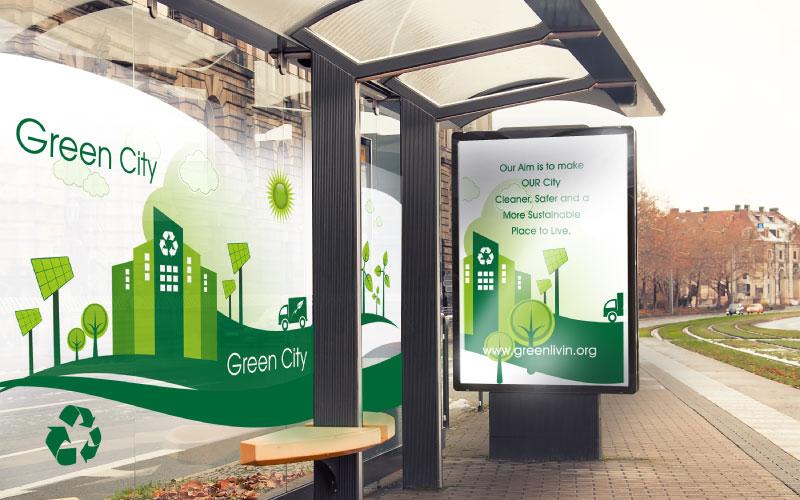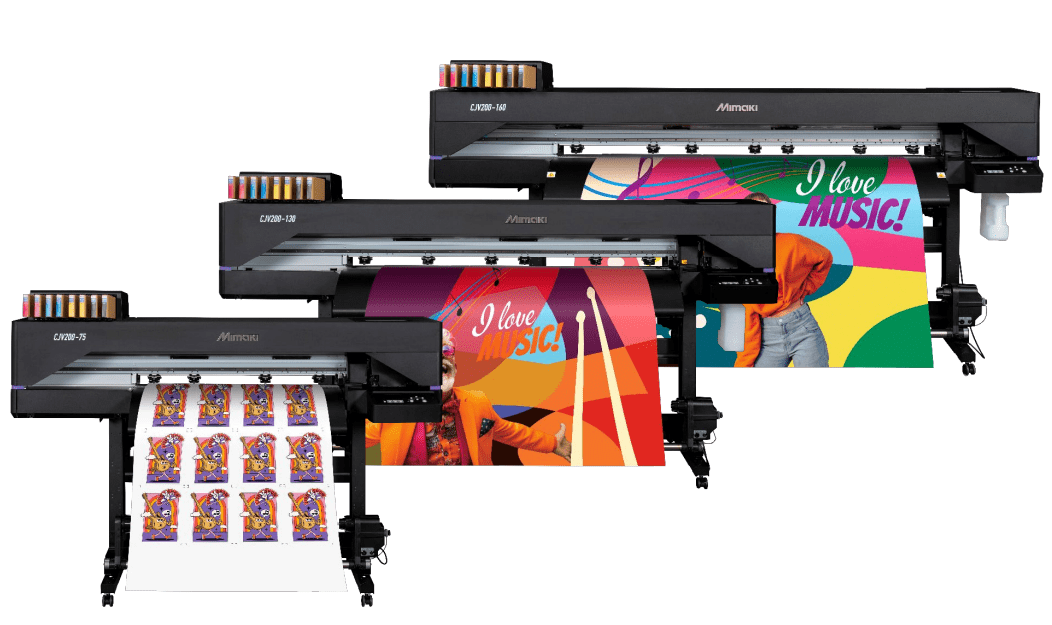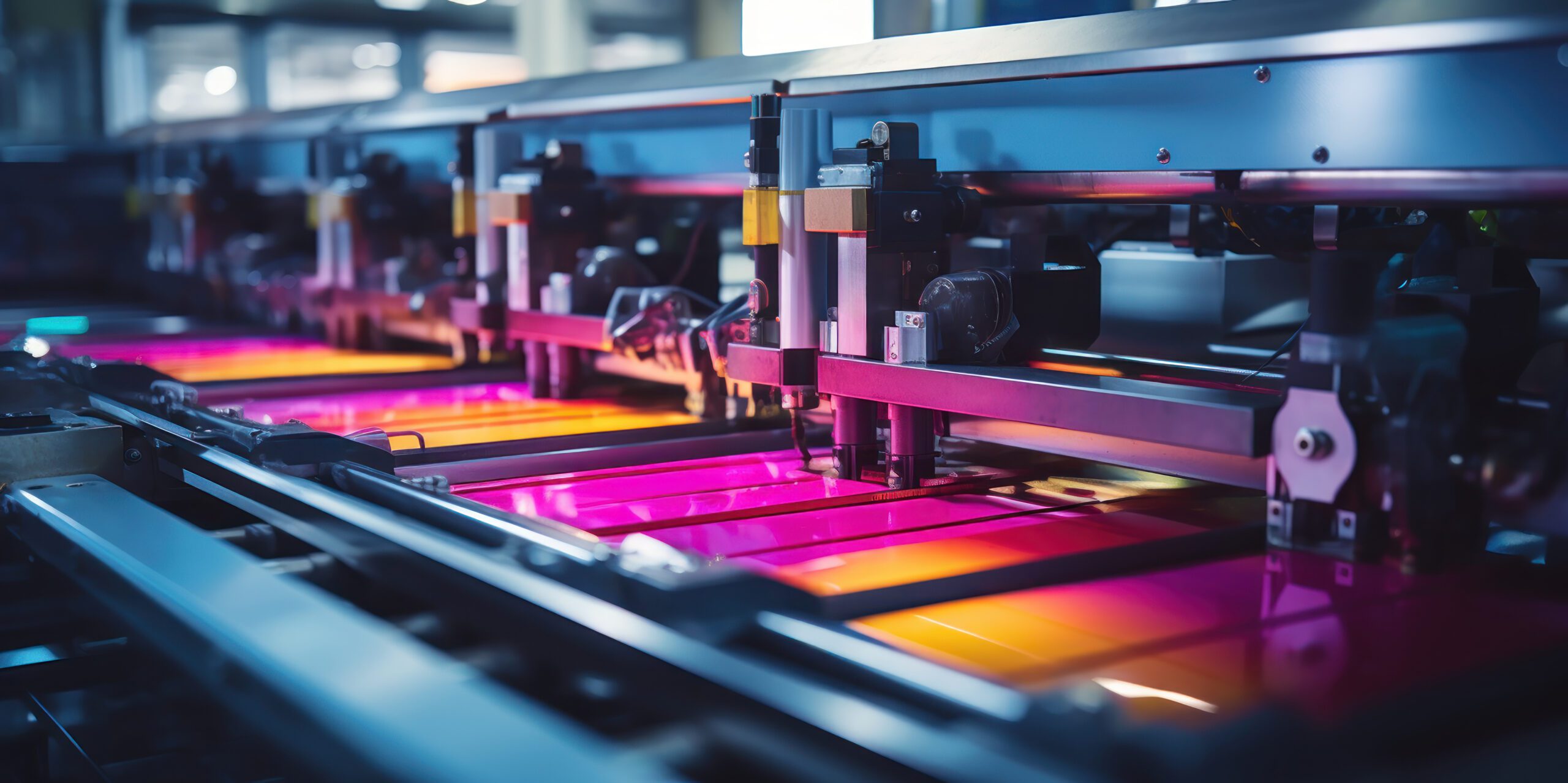Colour is compelling. From a cultural viewpoint, the colours you choose say a lot about how you project your style and the feel of your brand. From a design perspective colours like Cerulean Blue, Burnt Coral and Rust hit the mark for a classic, minimalist approach to colour-matching. But what is the most popular printing colour in 2021?
- Introduction
- Are There any Sustainable Substrates?
- What Kind of Printing Methods Are Eco-Friendly?
- A Closer Look at Eco-Friendly Inks and their Print Applications
- Improvements in Printing Technology
- What are the benefits of choosing eco-friendly printing?
- Best Practice For Eco-Friendly Printing
- What is Sustainability in Large Format Printing?
- The Green Economy enables additional revenue streams
- In Summary
By far and away the most important colour in the printing industry, and even more so when it comes to large format printing on an industrial scale, is green. This isn’t trendy shades like Green Ash, Sage or French Aqua but a focus on working with green credentials like environmental sustainability and eco-friendly best practices.
It is difficult to ignore how sustainability has matured from a buzzword into a strategic business model. Digital printing businesses around the world have also realised the need to adapt and to improve their sustainability in terms of emissions, waste and environmental impact.
Unfortunately many of the materials used in large format printing have for years included solvents, inks and substrates that are a long way from being considered environmentally friendly printing. However, print customers are becoming a lot more conscious of their environmental footprint and demanding print companies to supply and source more sustainable and eco-friendly products such as banners and printable textiles and fabrics. It means greener printing materials being developed and launched and being made readily available on the market.
So when customers are choosing the complimentary colours of Burnt Coral with Blue Marine, they are probably made with a lot more green than meets the eye.
Introduction
In large format digital printing, eco-friendly does not necessarily mean removing environmental impact. Many of the chemicals and processes that are used to make eco-friendly products are still harmful. However, as previous technologies that had a greater reliance on using solvents and harmful chemicals are starting to be overlooked in favour of cleaner, greener processes, eco-friendly materials, methods and applications are considerably more sustainable and proven to be less impactful to the environment.
As this technology advances, printing materials that are more organically and naturally occurring like vegetable-based inks will become more popular. So too will the development of more energy saving printing machines, like the introduction of low-energy UV lamps to cure inks. So what might be available today as eco-friendly will only become greener with every new product release. We’re just at the start of an era of environmentally more conscious consumers, printers and suppliers.

Are There any Sustainable Substrates?
When considering eco-friendly printing materials, small format printing can certainly tick the box with a wide variety of recycled paper (tree-free, hemp-based) options readily available. For large format printing the options are more limited, but that doesn’t mean new products aren’t being developed continually.
Synthetic materials like plastics are used throughout the large format print industry and often with good reason. They have an ability to withstand the harshest of elements, have excellent print properties and can handle adhesives and additional coatings with ease as well as being truly durable when handling.
Things are changing though, substrates have a bigger part to play in the ultimate sustainability of the printed product, whether that is a substrate made from 100% recycled, natural materials or just recycled.
Paper
The European paper recycling rate is around 74%, and this makes it one of the most widely recycled materials. Even when paper can no longer be used to make more paper, it can still be used to make other products like what is found in egg boxes and even used to make fertiliser.
When choosing paper, print companies should be looking for responsibly sourced, uncoated paper. For large format indoor displays, a non-reflective, matte surface is perfect. It also goes that paper products should be sourced within appropriate standards and ethics. The FSC (The Forest Stewardship Council) certification is the highest standard of wood sourcing, ensuring that it is socially considered (beneficial economically and socially) and has been taken from responsibly managed sources.
PVC-free
PVC free media include a variety of recyclable substrates that do not contain any PVC materials. In digital print media PVC alternatives are an eco-friendly alternative to standard PVC. Whether that be hemp, yarn or a composite material, they can be used inside or outside without compromising quality.
Recycled PVC
Everyone knows that synthetic materials like PVC carry a big carbon footprint, being made from fossil fuels. But if it has to be PVC, did you know that existing PVC can be broken down into small chips and then recycled and reused up to seven times. It even has a lifespan of over 140 years.
Paper-based board
A variety of paper-based rigid boards are available which utilise less plastic include cardboard and cardstock using branded names like Falconboard, Bulldog Board and EnviroBoard.
These are rigid paper-based boards suitable for large format printing. There is usually a coating on both sides for high quality print graphics, whilst inside it is fully biodegradable and fit for recycling. Ideal for indoor installation of display media, hanging signs, retail signage and presentation boards. The same concept can also be used using corrugated or honeycomb-like cells within the board to make it thicker, but retaining the lightweight benefits of using paper.
What Kind of Printing Methods Are Eco-Friendly?
So, how green are current printing methods and technologies, and which are the best to use? While this isn’t easy to answer with 100% accuracy, it is fair to say that some processes are certainly less harmful to the environment than others. Here is a quick list of some of the more eco-friendlier printing methods:
Vegetable-based inks – These are made up of renewable resources such as cottonseed, linseed and tung oils, all natural products meaning waste inks can be easily recycled and made into new inks.
Soy inks – Some inks contain even fewer volatile chemicals than vegetable-based inks. Soy inks are so gentle on the environment but are still able to ensure vivid, high quality print images. Again, these inks can be reused into newer inks.
Screen printing – The method to produce screen prints has changed. While previously it used high levels of solvents, now the adoption of UV inks cured using low energy UV lamps have virtually eliminated the use of harmful solvents in this new eco-friendly screen printing process.
Water-based aqueous printing – As the name suggests a water-based ink is going to be less impactful to the environment than one using harmful VOCs. Even more so, an additional water-based coating provides protection, but in a totally recyclable way.
Digital printing – Without the need for additional plates to carry the ink, direct to substrate digital printing produces much less waste by eliminating costly test print runs.
Biopolymer printing – It’s plastic, but not as we know it. Biopolymers are manufactured plastics utilising corn and other vegetables to produce an alternative substrate material.
PCF Paper – That’s Process Chlorine Free paper to you and me. This is paper that has been bleached using 100% natural compounds. Reducing the amount of chlorine bleached chemicals into the environment makes this option particularly eco-friendly.
Font selection – It might surprise some, but using some fonts will require significantly more ink than others. The more ink you use, the higher the cost to manufacture and the more chemicals are used.
And the future of ink printing doesn’t stop here either, technologies like algae ink are close to becoming marketable. They claim to be even more environmentally friendly as they use none of the oils of vegetable or soy-based inks and are considered biorenewable.

A Closer Look at Eco-Friendly Inks and their Print Applications
Each sector of the print industry should, and often does, take their environmental impacts seriously. Production technology as whole over the last ten years has been led by innovations in both quality and sustainability. The preference for water-based ink has been one such step towards developing eco-friendly products that perform even in the most demanding of environments.
Natural inks
Modern, eco-friendly printers often now utilise vegetable-based inks or soy-based inks as an alternative to using harmful petroleum products. These inks are not only less intrusive to the environment but are also easily removed prior to recycling and can still create high-quality images.
Eco-solvent ink
While there remains a multitude of reasons why solvent-based inks are still preferred in signage and other print media, the development of eco-solvents has significantly reduced the environmental impacts of this ink application.
Eco-solvents use virtually none of the harmful VOCs (Volatile Organic Compounds) used in traditional solvent printing. In fact, unlike traditional solvents, they use up to 50% of their monomers and oligomers from naturally-producing resources, like renewable plant or biomass materials. When combined with LED lamps for curing instead of cooling using mercury-based products it means the results are no loss of quality but a big reduction in the production of greenhouse gases.
Latex ink
An attractive alternative to solvent-based inks has been the use of latex inks. This 70% water-based ink has two distinct properties making it an eco-friendly application. Firstly it penetrates the substrate just like solvent-based inks, meaning the substrate itself can be further recycled. Secondly, latex is biodegradable, in the right conditions, it can biodegrade at the same rate as leaf litter from trees.
Latex does not emit gases or odours and contains none of the VOCs which are harmful to the environment, meaning indoor applications can be performed without the need for air extraction or ventilation – safer for printing operatives and safer for end-users.
UV ink
UV ink uses fewer toxins and the heat drying process enables all of the ink to be used rather than being evaporated like in solvent inks making UV printing more efficient in that it uses up to 20% less ink than other wide format print technologies, ans as UV lamps can be fitted to the print head, it can cure the ink immediately making UV coatings eco-friendly when done in an energy-efficient manner.

Improvements in Printing Technology
New printing technology emerges year on year to provide the industry with ever more efficient ways of converting high quality digital print images onto signage or as part of media displays.
Developments in large format printing technology have aligned with sustainability goals to push operational costs lower through the use of low energy efficient technology, and still focus on speeding up the print process.
Some of the latest developments in eco-friendly printer technology include:
UV LED lamps – Utilise UV lamps attached to the print head which are developed to last longer and be more energy efficient than conventional lamps.
Hybrid print heads – Using multiple sized ink dots to produce multiple different colours and used to create layered effects.
Automation – Removing human-interaction with print processes can lead to great efficiency of materials and optimised print runs. Digital printing software has revolutionised the efficacy of large format printing, leading to less waste and shorter handling times.
Smart filters – Eco-friendly printer filter technology developed to make use of more organic compounds to neutralize toxic solutions to reduce and avoid potential contamination and reduce waste processes.
What are the benefits of choosing eco-friendly printing?
No loss of quality – The range of print inks available that are less harmful and contain fewer VOCs are not only getting bigger, but the constant drive for sustainable printing methods means that the print quality levels are also improving, in terms of vivid colour and life-span. All the while having the environmental benefit of being fully recyclable.
Reduced carbon footprint – Now, more than ever, everyone’s carbon footprint matters. From individual decisions to wholesale purchasing choices, there is an emphasis on people doing their bit to reduce carbon dioxide emissions. Large format printing businesses are no different. The Carbon Trust estimate paper as the biggest contributor to CO2 emissions and when sustainable printing techniques are employed throughout, waste products are reduced, leading to cost savings and greener products..
Green credentials – Using recycled paper, for instance, is an obvious way of highlighting green credentials. Recycling paper is not only better for the environment but is also a lot cheaper than logging a path through a Scandinavian Forest.
Additional revenue streams – Being able to prove that print materials, products and processes are using less energy and have been responsibly sourced merely matches current consumer demand. This demand is often accompanied by a willingness to pay more for natural products by choosing suppliers who can prove their sustainability. These green factors are also being increasingly cited by health trusts, educational authorities when tendering out projects. But it is private industry who have the most to gain from sourcing their print products with a reduced carbon footprint matching end-user desire.
Health benefits – Some of the more traditional printing inks use compounds derived from petroleum. They can include VOCs, many of which have been identified as detrimental to health – and while it is unlikely that end users are exposed to these, it makes recycling them much more difficult. Greener printing inks don’t contain these volatile compounds.
Cost benefits – Adopting eco-friendly business practices naturally lead to cost savings. Energy conservation, recycling materials, using energy efficient equipment such as solar power and conserving or reusing water can all reduce costs for manufacturers.
Best Practice For Eco-Friendly Printing
When printing companies choose eco-friendly options, it doesn’t mean compromising on quality or choice. There is still a wide range of materials and applications that can be offered to customers and industry sectors that demand low carbon footprints and green credentials.
Waste Reduction & Reusing Waste
Reducing waste is all about ensuring print operatives are trained in the best digital printing practices to ensure waste product is kept to a minimum. Less waste means less landfill but using recyclable materials means eliminating all unnecessary waste.
Energy Consumption
It’s not all about the material used, the amount of energy required in large format printing is also a considerable factor in how eco-friendly the printing is. Eco-conscious print companies understand that the energy that goes into powering printing machines and the heat used in curing processes can be a considerable drain on resources.
Energy savings can be made in using solar power sources, ensuring buildings and facilities are energy-efficient and re-using water where possible. All of which have a huge role to play in reducing the total resources in any finished print product.
Reducing the impact of end-of-life products
When products are made using sustainable, renewable materials that can be recycled, it makes their end of life much friendlier to the environment. Paper-based boards can be recycled, inks can be recycled and other substrates can be made using biodegradable materials.

What is Sustainability in Large Format Printing?
There has been plenty of discussion during the last 5 years in the print industry surrounding the push toward sustainability. It is no secret that ink applications and the use of solvents, the curing and even the machinery itself cannot yet be described as being a technology that is 100% green or even without potential harm to the environment, in terms of waste disposal and manufacturing processes.
However, this has not stopped innovation towards greener technology that strives to produce less waste and more sustainable practices. In wide format signage for instance the adoption of PVC-free material that utilises 100% recycled yarn is yet another step towards eco-friendly product solutions.
There has also been a big increase in the usage of latex inks which are made up from 70% water, making it a much greener option than traditional solvent-based inks, as is the wider adoption of rigid paper board alternatives to plastics.
As the wider society in general makes a big push towards sustainability and greener technology, this too crosses over to the demands of customer loyalty through a commitment to reducing carbon footprints and lessening the environmental impact of their supply chains.
The Green Economy enables additional revenue streams
A recent study compiled by the environmental technology company GreenPrint concluded that over two thirds of its respondents were willing to pay more for products considered sustainable. In fact it went further to conclude that three quarters not only did not know how to identify sustainability but were likely to purchase a product just because it was labelled as environmentally friendly.
By engaging with eco-friendly products and sourcing more sustainable and environmentally conscious materials, printing companies can not only gain loyalty with new customers, they can also take advantage of revenue streams generated by the green economy.
By tapping into the green economy, business owners can not only foster stronger demand for their products and services, they can also capitalize on additional revenue opportunities. Something that is particularly poignant in the large format printing sector.
From minimizing waste in the design process to leveraging eco-friendly materials and technology, wide-format printing businesses stand to gain by employing sustainable practices.

In Summary
The large format print sector still has a long way to go before it can consider itself truly sustainable. In order for this to become a reality would mean further development of current greener material offering and a further reduction in harmful emissions. None of which is easy in an industry that already requires huge amounts of chemicals and solvents.
But attitudes toward sustainability and greener purchasing decisions are more evident and this consumer demand is clearly instigating change.
Progress will not be rapid, but already there has been big strides in the reduction of energy emissions in the print application process and a greater level of investment in using recycled material when producing substrates, like rigid paper board and PVC free. Then there is the development of cleaner, renewable ink technologies and a shift away from solvent-based inks; even if that is a shift to the slightly less harmful, but still harmful eco-solvents. More than ever the digital print industry has one eye on the future, committed to be more eco-friendly .









